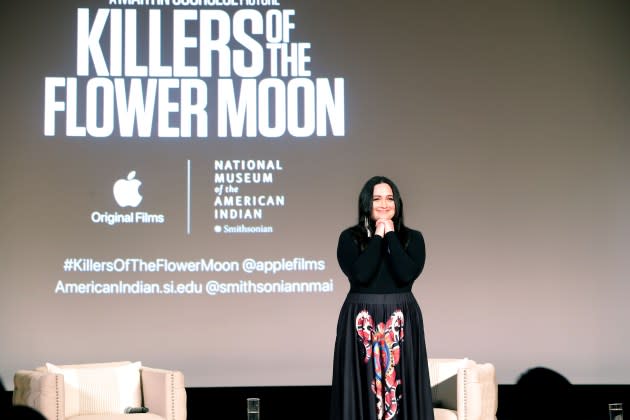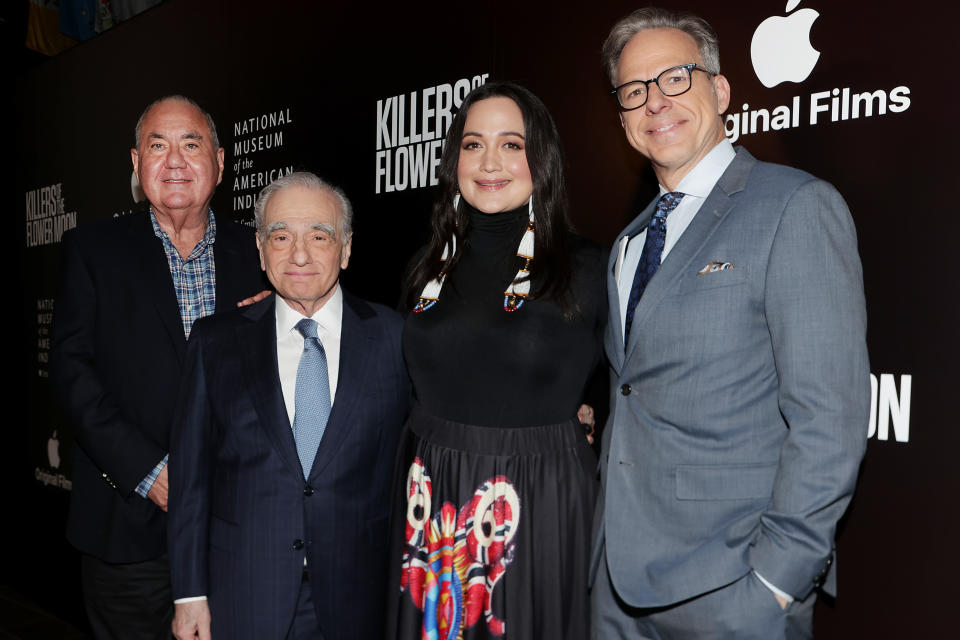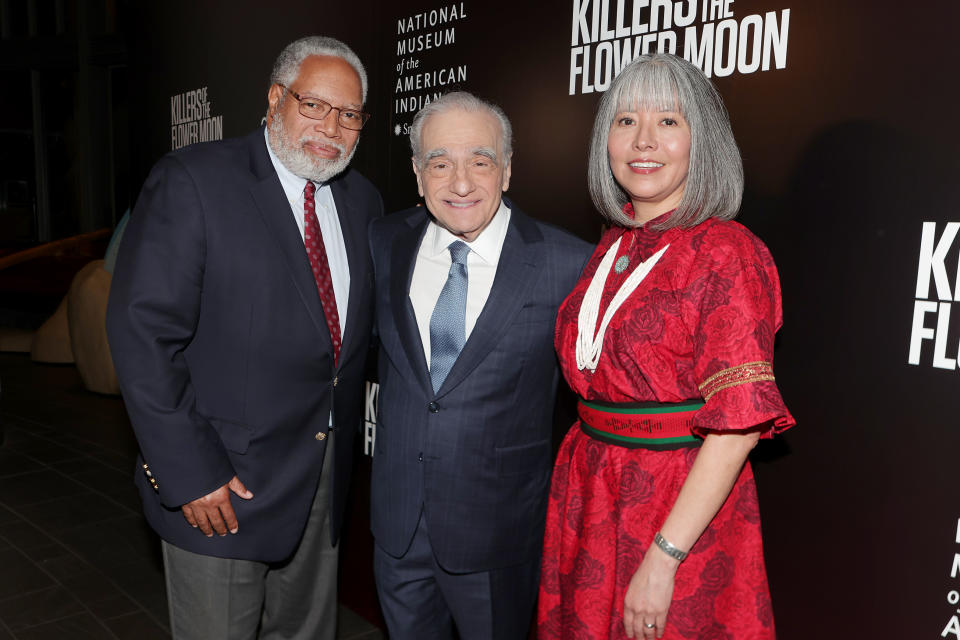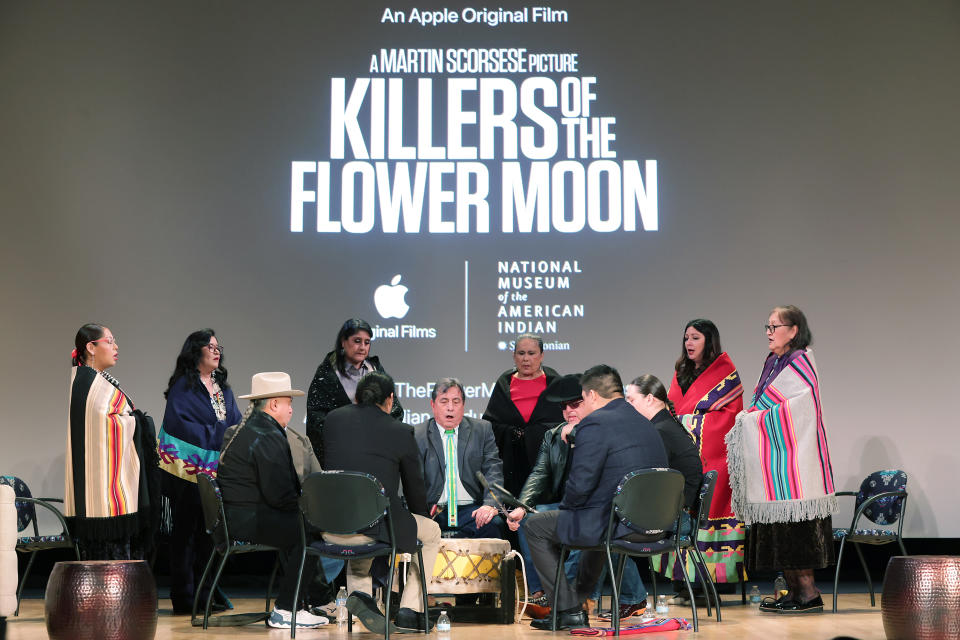“You Cannot Escape History”: ‘Killers Of The Flower Moon’ Honored At Smithsonian; Lily Gladstone & Martin Scorsese Discuss Depiction Of A Suppressed Past
- Oops!Something went wrong.Please try again later.
- Oops!Something went wrong.Please try again later.
- Oops!Something went wrong.Please try again later.
- Oops!Something went wrong.Please try again later.
- Oops!Something went wrong.Please try again later.

When the Smithsonian Museum of the American Indian hosted Apple Original Films’ Killers of the Flower Moon for an event on Friday, director Martin Scorsese and star Lily Gladstone talked extensively about the development and production of the Oscar-nominated epic.
But the multiple Oscar nominated film also is in line with so much of what the Smithsonian is trying to do, according to the Smithsonian’s secretary, Lonnie Bunch, and comes at a time when there is so much debate over the teaching of unvarnished chapters of the American past.
More from Deadline
“These kinds of films can help us heal, at the very least help us come to grips with our tortured racist past, come to grips with all the challenges of our history, of by doing that, we find our shared humanity,” Bunch said at the event. “We learn that [with] films like Killers of the Flowers Moon, you cannot escape history, but you can be made better by embracing the past, by understanding the past, by using that past to inspire, to challenge, to pry, to make sure we live up to the ideals of this nation.”

Scorsese and Gladstone were joined by the Osage Nation’s Chief Standing Bear for a conversation moderated by CNN’s Jake Tapper. About 300 guests attended, watching several clips from the movie, and listening to Scott George and Osage Singers perform the Oscar-nominated Wahzhazhe “A Song for My People.”
The film, which was nominated for 10 Oscars, including best picture and for Scorsese and Gladstone, is based on the David Grann book about the systematic murders of members of the Osage nation a century ago by white settlers to seize control of rich mineral rights. Scorsese and screenwriter Eric Roth adapted the book into a complex story of greed, love and betrayal, centering on the relationship between Mollie Kyle (Gladstone) and Ernest Burkhart (Leonardo DiCaprio), the nephew of political boss William King Hale (Robert De Niro) who orchestrates the murders.
In an interview with Deadline, Scorsese said that he believes the movie’s impact has been “an awareness and a new respect for indigenous culture. What I mean is there has been a dialogue, particularly the nature of how they have been depicted before. This is really the key, I think. But I always point out, the way that the Native American was depicted in the first half of the 20th century had to do with what America was at that time, how it has shifted now.”

He added, “It doesn’t mean that we should wipe away what was done in the 20th century. No, we have to know that. We have to see that’s how they were perceived by the white European, especially from the 1930s into the 60s. But I must say, there’s really been an incredible interest [in the Osage nation], and a respect and absolutely a kind of excitement about who they are and what they do and how they live and what their cultures are.”
That said, Killers of the Flower Moon was released amid efforts in some states to restrict how teachers can instruct students on American history. As Grann and Jim Gray noted USA Today last year, a 2021 Oklahoma law that restricts what educators can teach is so vague that instructors are wary of how much detail they can go into the book and Osage history. The law is part of a broader effort to “mask discomfiting truths” in school curriculums, Grann and Gray wrote.
Scorsese said the movie “came out at a time when this kind of thing was being debated. I always think, ‘Give both sides of the picture.’ Even the villains have their point of view, and it is important for young people to understand that. It’s important for us to know who we are as a nation, who we are as a people and as a culture, the good and the bad. I always feel that to wave the bad away and pretend it never happened, it is going to come out against us later on, if not our generation, the next generation.”
Also attending the event was Secretary of the Interior Deb Haaland, Museum of the American Indian director Cynthia Chavez Lamar and Sen. Maria Cantwell (D-WA). Other guests included Kevin Gover, the undersecretary of the Smithsonian; Michael Orona, senior adviser for global strategy and indigenous rights at the State Department; Catherine Brown Collins, director of film, TV and digital media programs at the State Department; and Walter Lamar, Indian Arts and Crafts Board commissioner.

Also at the event: actress JaNae Collins, consulting producer Chad Renfro and Osage wardrobe consultant Julie O’Keefe.
Tatanka Means, who plays federal agent John Wren, said that the movie was a “reintroduction to us in the film industry and the world and how people perceive us and learn about us, and our history, that this is real and that our story is finally being exposed.”
He added, “I did not know about this story until I heard that they were turning it into a film. I’m Navajo, Lakota, Omaha and Dakota. I’m from different tribes. We all have our own oppression that has happened to us, but to learn about each other’s traumas that happened is big, and we need to expose this kind of thing that has happened to educate America and our younger people about these atrocities. It’s American history.”
Gladstone, the first Native actress of American descent to be nominated for best actress, told attendees about being cast for the part, a journey that started with an audition in August, 2019, followed by the delays of Covid.
At one point, Gladstone said that she was preparing to take data analytics course to seek a part-time job and “do something else for a little while.” But she recalled being on her laptop and getting getting a Gmail notification that said “Zoom with Martin Scorsese.” That led to readings with Scorsese, and then a meeting over Zoom with DiCaprio. “So I was able to do this life-changing audition from the comfort of my old bedroom in my parents’ house, with them waiting in the living room,” she said. Her representatives got the offer and, in the excitement of landing the part, she said that she realized it was December 1, Mollie Burkhart’s birthday. It wasn’t planned that way, she said, “but that felt like a sign that there was some kind of approval coming from something greater than I could even say.”
Scorsese said of casting Gladstone, “Maybe it is naivete or something. I just felt she was totally right.”
Scorsese also has a cameo at the end of the movie, as a radio show producer who reads Mollie’s obituary. Scorsese told attendees that he did the part because “by the time that we had to shoot it, I felt that the obituary had to be acted a certain way, and I didn’t know how to direct another actor. I just didn’t know what to tell that person, and who that person could be.”
The scene was shot at his old high school in the Bronx, and his wife, daughters and granddaughters were there along with friends.
“As I was doing it, the language of it, particularly the lining up of her mother, father, sisters, a daughter, and the repetition of it, even now I feel the emotion of it,” he said. “And I think that happened on screen. And then I said, ‘And these things never mentioned again.’ And I just realized, no mention of it, murders at all. But I saw the kids and I thought of my own family. I thought of all our families, and what it would be like, because I was at those graves, and it hit me.” Friends and actors who watched him do the scene told him his performance was good, Scorsese recalled, “I said, OK, I don’t have to reshoot it then.”
Best of Deadline
Hollywood & Media Deaths In 2024: Photo Gallery & Obituaries
2024 Premiere Dates For New & Returning Series On Broadcast, Cable & Streaming
TV Cancellations Photo Gallery: Series Ending In 2024 & Beyond
Sign up for Deadline's Newsletter. For the latest news, follow us on Facebook, Twitter, and Instagram.

